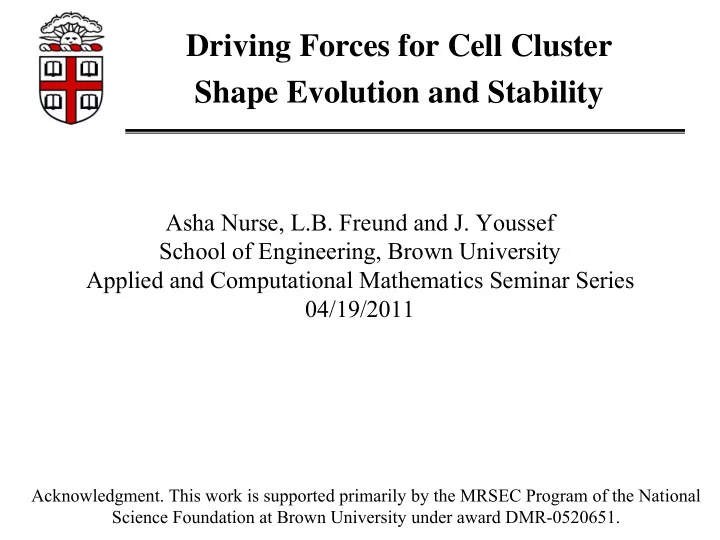

Driving Forces for Cell Cluster Shape Evolution and Stability Asha Nurse, L.B. Freund and J. Youssef School of Engineering, Brown University Applied and Computational Mathematics Seminar Series 04/19/2011 Acknowledgment. This work is supported primarily by the MRSEC Program of the National Science Foundation at Brown University under award DMR-0520651.
Outline • The Model – Experimental Background – Origin of Surface Energy – Analysis of the Model – Results & Conclusions • Linear Stability of a Toroidal Cluster – Stability Analysis – Formulation of Model • Calculating Surface Area and Volume of Perturbed shape • Alternate Perturbed Shape – Non-constant Surface Energy Density – Results & Conclusions
Directed Self Assembly Experiments Dean, D. M., Napolitano, A. P., Youssef, J. and Morgan, J. R. FASEB 2007
The Phenomenon 800 μ m solvent cell suspension toroidal cluster polyacrylimide chamber A mathematical model of the current system will 1. allow for understanding the factors involved in cell cluster reorganization 2. offer a framework to organize lab observations
Spontaneous Climb 200 μ m 2 hrs 4 hrs 6 hrs
The Model Nurse, A., Youssef, J., Freund, L.B. JAM 2011 Under Review
Possible Origin of Surface Energy tension bundles Higher free energy
The Model
Finding the Surface Flux
A Variational Approach
Numerical Solution for Shape Evolution κ = κ eq κ = 15 α ( τ )/b 0 ω =100 a( τ )/b 0 κ = 25 20 25 β ( τ ) β ( τ ) τ
Numerical Solution for Shape Evolution κ = κ eq κ = 15 α ( τ )/b 0 a( τ )/b 0 ω =100 κ = 25 20 25 β ( τ ) β ( τ ) τ
Numerical Solution for shape evolution α = 85 a( τ )/b 0 65 55 β ( τ ) τ
Extraction of Surface Energy Density Values α 1 = 55°, α 2 = 65° time γ m s (hrs) (mJ/m 2 ) 10 -14 (m 4 hr/g) 2 0.0580 0.543 4 0.0638 0.920 6 0.0667 1.238 8 0.0693 1.386 Foty & Steinberg (05) & Sivansankar et al (99): 1.556 x 10 -4 ≤ γ ≤ 1.522 x 10 -3 mJ/m 2
Conclusions from the Basic Model
Outline • The Model – Experimental Background – Origin of Surface Energy – Riemannian Geometry – Analysis of the Model – Results & Conclusions • Linear Stability of a Toroidal Cluster – Stability Analysis – Formulation of Model • Calculating Surface Area of Perturbed shape • Alternate Perturbed Shape – Non-constant Surface Energy Density – Results & Conclusions
Stability of Toroidal Shapes a 0 / b 0 ≈ 1.9 a 0 / b 0 ≈ 8.7 Jeff Morgan Lab Pairam & Fernandez-Nieves, Physics Rev. Letter 2009 McGraw et al, Soft Matter 2010
Linear Stability Analysis of the Toroidal Cluster
Linear Stability Analysis of the Toroidal Cluster
γ is spatially constant Always stable
Alternate perturbed shape Inconclusive
γ is not spatially constant θ r 0 r 0 a 0 a 0
Nonuniform γ with same applied perturbation r 0 /b 0 = 4 stable unstable
Non uniform γ with same applied perturbation r 0 /b 0 = 4 stable unstable r 0 /b 0 = 8 stable unstable
γ is a function of position on the surface
Conclusions on Toroidal Stability
Summary of Results on Toroidal Clusters Formation of uniform toroidal self-assembled cluster at base of chamber Remains at base of chamber Cluster spontaneously climbs undergoes localized thinning conical pillar to around circumference reduce its surface area Rate of climb affected by For family of applied perturbation • influence of SE/GPE ( κ ) • γ must be a variable • γ ( θ ) sufficient for instability • slope of conical pillar ( α ) • surface mobility of diffusing cells • r 0 /b 0 affects cluster stability
Further Work and Questions Origin of γ requires further investigation • • More precise method required to extract values of m s • Conduct linear stability analysis of toroidal shapes with – other family of perturbations – more complex surface energy density function • For spatially constant γ , conduct a nonlinear stability analysis of the toroidal clusters
Acknowledgements & Publications 200 μ m
Recommend
More recommend